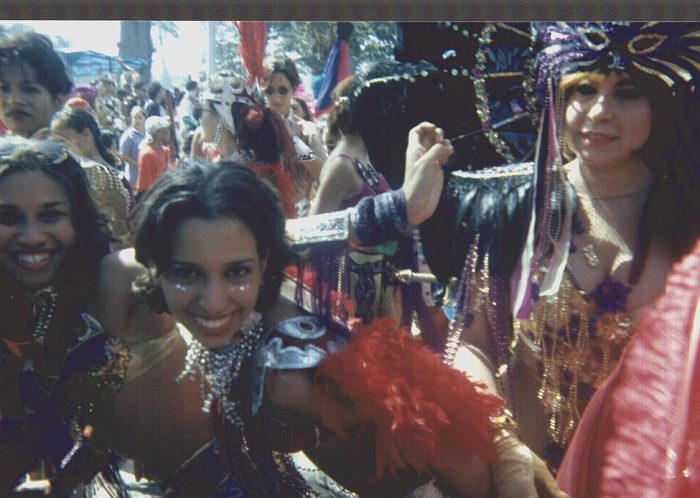It’s Carnival Tuesday in the sweet islands of Trinidad and Tobago.
The intense, sticky Caribbean heat saturates the air, making it impossible not to drip with sweat.
The sun, high in the sapphire sky, beats down on the crowds of flamboyant revellers in the fiery streets. The heat so intense that parts of the road paved purely in asphalt begin to go spongy soft under the relentless pounding of dancing feet.
The rhythm of the lurid music blasting from giant speakers perched on music trucks causes currents of movement through the crowd. The collective exuberance of all masqueraders fills the atmosphere. A kaleidoscope of colour can be seen in every direction as they collide and the diverse colours of their costumes blend to create a harmonious animated mosaic.
Glitter, sequins, beads, and multi-coloured feathers reflect the sun’s rays, blinding excited onlookers. Exposed skin and beautiful bodies of all sizes, shapes, and shades sway everywhere. The smell of excitement and anticipation palpable all around.
Mouths dry, but souls quenched, we dance on.
I was only 17 the first time I “played mas,” as we say here.
It was a spiritual experience like no other, and like all spiritual experiences, we can only fully understand it if we go through it ourselves.
Every year in February or March, the country dedicates two days to the celebration of Carnival. It signals the start of the Christian Lenten season. Carnival involves the parade of a multitude of “bands” or different groups of masqueraders, and each band is comprised of various sections that are individually themed. The parade is open to the public; anyone can sign up and purchase a costume.
On Carnival Monday and Tuesday, the streets of Port of Spain are closed off to vehicular traffic and open to the parade—and the public—who essentially dance-walk through the city streets in a fashion we call “chipping.” Some people wait all year for this release—the chance to forget all of their problems and cares in favour of having a good time, if only for those two days.
There is a particular genre of music dedicated to the event. It’s called “Soca.” The catchy beat of this rhythmic music can take anyone to their happy place, and it makes movement of the waist inevitable.
I remember that first year of playing mas.
Fifteen or so young girls in an all-girls section—we were in the most beautiful shade of red, with silver accents. All of us in the same costume comparing what small adjustments we each made to personalize our costumes to our own unique quirks and buzzing with the anticipation of our days on the road.
We were armed with our disposable cameras trying to capture these moments that would soon become our history. As we chipped down the crowded streets, in true “Trini” fashion, I couldn’t help but look up at the expanse of azure sky and think, “Wow, how lucky am I to have been born into this sweet Caribbean culture, with this experience called Carnival!”
As we jumped, waved, chipped, and gyrated our waists in the typical circular motion, commonly called “wining,” I floated away on the euphoria of the moment, up into the heavens.
I’d never experienced such bliss before, such feelings of complete freedom and fulfilment. Maybe it was the music, maybe it was the heat, maybe it was the profound sense of oneness I felt with the entire community of masqueraders all around me. One way or another—it was the deepest meditation I have ever experienced.
Thankfully, this feeling was not an isolated incident for me. It has followed me throughout my life but it is always magnified by movement, particularly movement through dance.
The feelings of oneness are felt, not just whenever I play Carnival, but also whenever I dance.
I’ve practiced many types of dance over the years from ballet, modern, and tap to Latin and ballroom. My favourite, and the one I still practice to this day, is Latin dancing. And it is in this that I have found that same 17-year-old girls’ euphoria all over again.
There is something about the “patak bak patak bak” of Salsa, or the “one two three tap” in Bachata music that sets my soul ablaze. I can’t help but move. Even if I’m not actually partner dancing, I’m moving: a toe, a finger, my hips. It is inescapable.
And when I’m suspended mid-spin and the whole dancefloor slows down in my peripheral vision, if only for a moment, I glimpse the depths of perfection once more. My feet grounding in time with each drum beat, or in between, my hair soaring in the space around my head, momentum moving me—it’s a spiritual experience all over again.
Movement, surrounded by community, unified in bliss. The assembly of dancers are a diverse and colourful group: all ages, all races, all social strata, all personalities, but all united by the magic of movement.
The stillness and silence practiced in traditional meditation is aimed at quieting the mind to unlock the inherent connection between our small individual sparks and the Super Spark. For me, the same is achieved in this movement, and more so, the collective movement of many. It ushers in unity, oneness, the melting of the individual into the whole.
For me, the most profound and meaningful spiritual experiences are to be had in movement as meditation.
~











Read 9 comments and reply